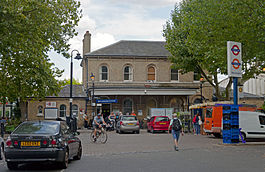
Back كيو غاردنز (محطة مترو أنفاق لندن) Arabic Kew Gardens (stanice metra v Londýně) Czech Bahnhof Kew Gardens German ایستگاه کیو گاردنز (لندن) Persian Kew Gardens (métro de Londres) French 丘嘉登茲站 GAN Kew Gardens állomás Hungarian Stazione di Kew Gardens Italian Stazion de Kew Gardens LMO Stesen Kew Gardens (London) Malay
| Kew Gardens | |
|---|---|
 Main entrance on the eastbound side, 2014 | |
| Location | Kew |
| Local authority | London Borough of Richmond upon Thames |
| Managed by | London Underground[1] |
| Owner | Network Rail |
| Station code(s) | KWG |
| DfT category | D |
| Number of platforms | 2 |
| Accessible | Yes[2] |
| Fare zone | 3 and 4 |
| London Underground annual entry and exit | |
| 2019 | |
| 2020 | |
| 2021 | |
| 2022 | |
| 2023 | |
| National Rail annual entry and exit | |
| 2019–20 | |
| 2020–21 | |
| 2021–22 | |
| 2022–23 | |
| 2023–24 | |
| Key dates | |
| 1 January 1869 | Opened (L&SWR) |
| 1869 | Started (NLR) |
| 1870 | Started and Ended (GWR) |
| 1 June 1877 | Started (MR and DR) |
| 1 January 1894 | Started (GWR) |
| 31 December 1906 | Ended (MR) |
| 31 December 1910 | Ended (GWR) |
| 3 June 1916 | Ended (L&SWR) |
| Other information | |
| External links | |
| Coordinates | 51°28′38″N 0°17′07″W / 51.4771°N 0.2853°W |
| Designations | |
|---|---|
Listed Building – Grade II | |
| Official name | Kew Gardens station |
| Designated | 26 September 2002 |
| Reference no. | 1031878 |
Kew Gardens is a Grade II–listed[9] interchange station on the District line of the London Underground and the Mildmay line of the London Overground. Located in Kew in the London Borough of Richmond upon Thames, it first opened in 1869 and is now managed by London Underground. The station, which is in Travelcard Zones 3 and 4, is situated midway between Gunnersbury and Richmond stations.
The station is the nearest to Kew Gardens, about 500 yards (460 m) to the west, and The National Archives, about 600 yards (550 m) to the north east. Kew Gardens Station Footbridge, also a Grade II-listed structure,[10][11] is next to the station, on the southern side.
- ^ "Safety boost as London Underground to take control of 11 Silverlink stations". Transport for London. 5 December 2006. Retrieved 29 July 2015.
- ^ "Step free Tube Guide" (PDF). Transport for London. April 2021. Archived (PDF) from the original on 15 May 2021.
- ^ "Station Usage Data" (XLSX). Usage Statistics for London Stations, 2019. Transport for London. 23 September 2020. Archived from the original on 9 November 2020. Retrieved 9 November 2020.
- ^ "Station Usage Data" (XLSX). Usage Statistics for London Stations, 2020. Transport for London. 16 April 2021. Retrieved 1 January 2022.
- ^ "Station Usage Data" (XLSX). Usage Statistics for London Stations, 2021. Transport for London. 12 July 2022. Retrieved 7 September 2022.
- ^ "Station Usage Data" (XLSX). Usage Statistics for London Stations, 2022. Transport for London. 4 October 2023. Retrieved 10 October 2023.
- ^ "Station Usage Data" (XLSX). Usage Statistics for London Stations, 2023. Transport for London. 8 August 2024. Retrieved 16 September 2024.
- ^ a b c d e "Estimates of station usage". Rail statistics. Office of Rail Regulation. Please note: Some methodology may vary year on year.
- ^ Historic England (26 September 2002). "Kew Gardens station (1031878)". National Heritage List for England. Retrieved 1 August 2020.
- ^ Historic England (26 September 2002). "Footbridge at Kew Gardens station (1031879)". National Heritage List for England. Retrieved 1 August 2020.
- ^ "Kew Gardens Station Footbridge". Urban Design. Transport for London. Archived from the original on 16 August 2012. Retrieved 1 March 2013.
